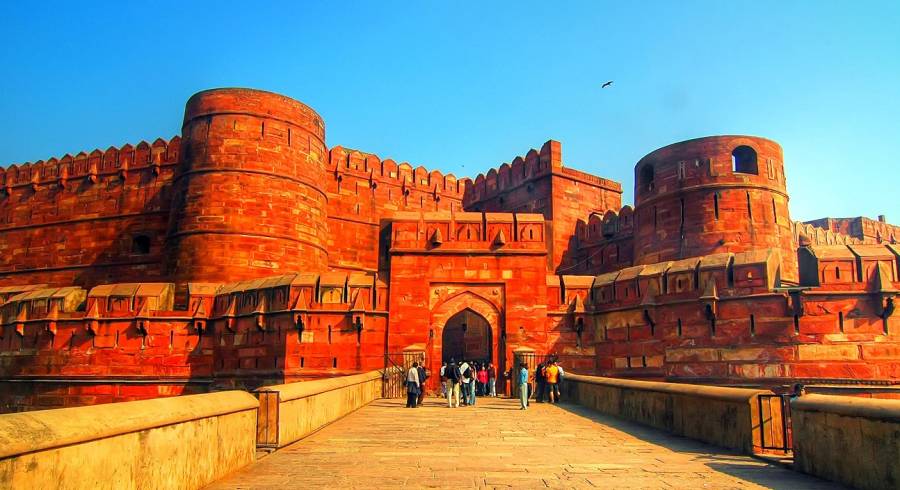Go beyond the postcard image to learn about the tragic history and marvels of the Taj Mahal.
Few sights in the world can match the iconic Taj Mahal. The magnificent monument in the historic city of Agra, India, is among the world’s most beautiful buildings. A masterpiece of Mughal architecture and a symbol of enduring love, the Taj Mahal is a UNESCO World Heritage site that attracts millions of visitors from around the globe who come to admire its grandeur and witness its timeless beauty.
Here’s what to see at the Taj Mahal:

1. The Architectural Marvel
A richly adorned regal gateway with impressive arches ushers you into the picturesque Taj Mahal complex, spread across an area of twenty-two acres. As you walk on, gradually the mesmerizing ivory-white marble monument comes into view. The Taj Mahal stands proudly with its large central dome, flanked by four minarets in perfect symmetry that give a three-dimensional effect to this striking edifice. Its marble exterior is adorned with intricately carved inlays, calligraphy, and decorative motifs.
The white marble mausoleum with a 35-meter-high dome is the highlight of the complex. It is surrounded by meticulously landscaped Persian-style quadrilateral gardens inspired by the gardens of Paradise described in the Quran. The pavilions and fountains with reflecting pools mirror the monument’s splendor, and the Yamuna River flowing nearby creates an idyllic ambiance that amplifies the Taj Mahal’s beauty.
2. A tragic romance
The Taj Mahal is an eternal love story immortalized in white marble and yet its majestic presence is shrouded in a sorrowful tale. It is a grand mausoleum, a palatial grave, built by a grieving emperor in memory of his queen. (In the inner chamber lie the cenotaphs of Shah Jahan and Mumtaz Mahal).
Legend has it that the Mughal Emperor Shah Jahan first spotted his future wife in the bazaar at Agra, selling silks and beads. He fell madly in love at first sight with Mumtaz and pursued her for five years before marrying her in 1612. Tragically, Mumtaz died after giving birth to their 14th child.
Shah Jahan constructed the Taj Mahal in her honor, with the help of architects and artists from all across the land. It took twenty-two years and 20,000 workmen including masons, stone cutters, inlayers, carvers, painters, calligraphers, dome builders and other artisans from India, Central Asia and Iran to complete the exquisite marble structure. Subsequently, Shah Jahan found himself stripped of his empire by his own son, imprisoned in a gilded cell with a poignant vista of the enchanting, melancholic mausoleum of his beloved Mumtaz Mahal.

3. Poetry in stone
The Taj Mahal is architecturally brilliant with exquisite craftsmanship. One of the highlights is the intricate marble inlay throughout the structure. Exquisite carvings, delicate floral and geometric patterns in marble along with the use of precious and semi-precious stones known as pietra dura is a testament to the skilled craftsmanship of the artisans. Gemstones such as jasper, agate, black onyx, lapis lazuli, amethyst, etcetera were inlaid by hand into the finest marble sourced from the quarries of Makrana. The attention to detail is evident in every aspect of this masterpiece. The Taj Mahal represents a fusion of distinct architectural styles, blending Persian elements with Islamic and Indian influences. This amalgamation of aesthetics creates a unique and captivating structure that showcases the cultural diversity and artistic heritage of the Mughal Empire. The Taj Mahal is considered to be the finest of the entire range of Indo-Islamic architecture.
4. Stunning vistas
The Taj Mahal sits on the curve of the Yamuna River. The Riverfront creates a striking reflection of the monument, particularly during sunrise and sunset. The ever-changing sky and ominous clouds create a fitting backdrop to the Taj displaying its glory. The sky changes hues from honey-colored at dawn to cobalt blue during the day, pink brush strokes at sunset, or luminescence under a full moon to magnify Taj’s aura. During your visit, explore different viewpoints around the Taj Mahal complex to capture the best angles and perspectives of this architectural marvel. Designated areas assist you to appreciate the grandeur of the monument and capture memorable photographs. Each glance,regardless of the viewpoint, reveals its sublime grandeur and leaves a mark on those fortunate to witness its magnificence. Whether bathed in golden sunlight or the ethereal glow of the moon, the Taj Mahal radiates a timeless charm.

Taj Mahal Sunset Timelapse
Our Insider Tips for visiting the Taj Mahal:
1. Best season for the trip
Though you can visit the Taj Mahal year-round, we recommend the dry winter season, from October to March when it is pleasant to explore the monument. In the summer months from April to June, temperatures can soar to 122°F (50°C); the monsoon lasts from July to September.
2. Best time to visit
It will take you two or three hours (the maximum time permitted is three hours) to explore the mausoleum, gardens, and surrounding buildings. (Except for a full moon visit which allows guests to stay only for 30 mins). Sunrise is the best time of day to visit when crowds are less, the weather is pleasant and the lighting is ideal, to view the monument and take photos.
3. Stay and accessibility
Staying in Taj Ganj will give you easy access to the Taj Mahal and nearby monuments ahead of the crowds. We recommend booking tickets in advance. Guests are dropped off 600 mts away from the entrance as petrol and diesel vehicles near the monument are prohibited to control pollution. You can either walk or take an electric cart.
Stay at The Oberoi Amarvilas
The Oberoi Amarvilas is a beautiful palatial hotel in the heart of Agra with stunning views of the Taj Mahal from every room. It narrates tales of Mughal grandeur and heritage with its majestic furnishings, antique décor and regal hospitality. Savor Mughal and international cuisine at an al fresco dinner by the swimming pool or indulge in a private dining experience with the Taj Mahal as your backdrop!
Beyond the Taj
A glimpse of Agra’s key attractions curated by Enchanting Travels’ specialists, that must be part of your Agra travel itinerary!

1. Explore the Agra Fort
Another architectural masterpiece, The Agra Fort is located at a distance of 2.5 km from the Taj Mahal. Built by Emperor Akbar, (Shah Jahan’s grandfather) in 1573 this sprawling fort was a Mughal residence and is now a UNESCO World Heritage Site. Within its premises lie impressive courtyards and buildings like Khas Mahal, Diwan-I-Aam, Jahangiri Mahal and Moti Masjid. The view of the Yamuna River and the Taj Mahal from the fort’s pavilions is stunning.
2. Watch Mohabbat – The Taj Mahal Story at the Cultural and Convention Centre
Enjoy an evening of dance and drama, an 80-min show depicting Shah Jahan’s love for his beautiful wife Mumtaz Mahal. The Mughal era setting, enchanting performances, embellished costumes and extravagant stage settings are sure to enthrall you.

3. Embark on a culinary tour of Agra
Explore the lively city of Agra through its vibrant, centuries-old bazaars and architectural wonders. Feast on royal delicacies and street foods, whose recipes have been passed down through generations. Delve into the Mughal Empire’s culinary legacy through insightful explanations from your knowledgeable guide.
If you were wondering what to see at the Taj Mahal, we hope this has answered your questions. And if you are planning your trip to Agra or a Northern India sojourn, speak to our India travel experts to create an in-depth and bespoke experience.

